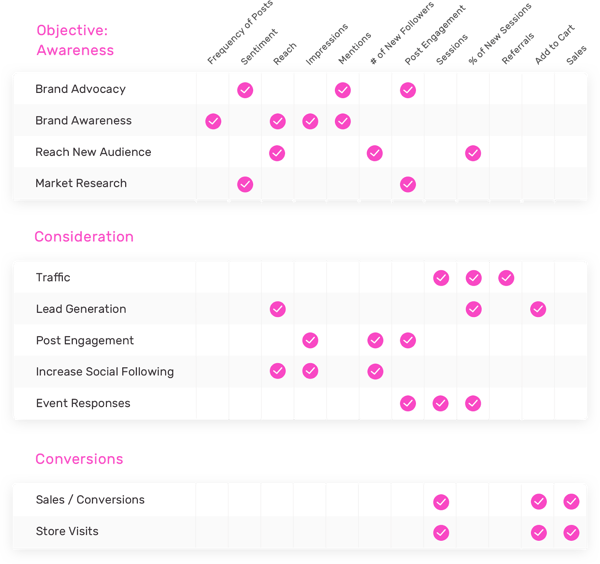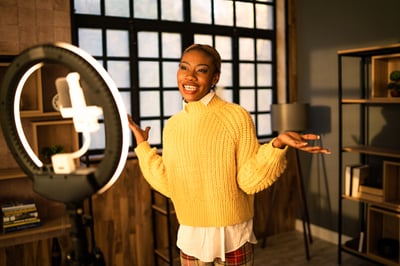August 4, 2020
 by Anthony Svirskis / August 4, 2020
by Anthony Svirskis / August 4, 2020

Worked with influencer marketing before? Not like this.
The influencer marketing industry has grown considerably over the last few years with a large number of brands jumping on the bandwagon. However, while this year has seen such growth, many brands are still behind when it comes to measuring and understanding the effectiveness of influencers.
Behind us are the days of influencer initiatives that are time consuming to manage and aren’t built for scale. Nowadays, influencer marketing is a way for brands to leverage user-generated content in a more efficient way that actually has you seeing results. It’s simple. If you have customers, you have reach and you have content.
Influencer marketing isn’t a new concept; it's been around for awhile, and the systems that have been set up to manage collaborations are outdated. But as this channel grows in effectiveness and marketers see that they can now measure their creativity and scale their success, they need a better way to manage it all. In its early days, influencer marketing typically involved brands paying for the endorsement of one celebrity influencer or garnering dozens of influencers with large followings.
Now, more businesses have shifted their influencer marketing strategies from ‘macro’ influencers with 100k+ followers to ‘micro’ influencers who have smaller followings.
Today, influencer marketing allows you to access everyday people who already use and love your products, and activate them to do your marketing for you by being real brand advocates. It’s simple, it’s safe and most importantly, it performs.
The highest organic engagement is generated by influencers in the three to 10 thousand follower bracket. Remember, word-of-mouth is where the power of micro-influencers really lies - it’s far more powerful when someone you trust says “how good is that brand?” than the brand themselves saying “how good am I?”

It’s as simple as tapping into a pool of your most creative customers to quickly source a library of content upfront that is shot to the specifications you provide.
Perhaps the most important progression we’ve seen in the influencer marketing industry is its ability to be scalable. Sure, you once ran an influencer campaign that performed well, but did you double down and scale your success?
It may have been difficult or near impossible to do so in the past, but with various influencer marketing platforms and models there are finally better ways to manage an inbox full of influencers, their posts and their content. Volume and reach are no longer barriers to a successful strategy.
At scale, brands can generate the same level of audience reach as celebrity influencers by using a variety of smaller influencers, sparking multiple word-of-mouth recommendations to more-engaged audiences that spread like wildfire. This allows brands to spread their budgets across more-potent audiences for a fraction of the cost, and means they can play to their product strengths rather than relying on celebrity status.
Once upon a time, managing influencer marketing involved reaching out to influencers, one at a time, to come to a specific agreement. It involved spreadsheets with names, prices and numbers that often got out of hand. Thankfully, brands can better manage the nuances of disclosures, contracts and licensing, with all of this able to be outsourced, leaving your brand to get to market quickly and safely.
Influencer marketing may very well be one of the safest marketing channels out there. Unlike traditional influencer marketing, today you can have creators deliver content upfront that is both low-risk and low-cost. This means, you get to review the content and select the influencers you’d like to work with based on the content they've submitted. In short, you get to see what creators will post, before you pay for it and before it launches to their followers.
Setting a campaign up for success is simple. Here’s what marketers need to nail before they launch their campaign.
Understanding what you’re trying to accomplish will help you identify your key metrics and set the tone for how you work with influencers. To get the most out of your campaign, you’ve got to ask yourself what you want influencers to convey.
Do you want them to build brand awareness in their community, drive traffic to your website or directly sell a product? Clarifying your objective is crucial for nailing your creative direction. A good exercise for this is to clearly identify what content you're looking for in seven words or less.
A mood board really does speak a thousand words and might just be the most important part of running a successful campaign that’ll deliver the goods you’re after.Your moodboard images have more influence over the quality of submissions than any other part of your brief.
Providing images you’d like to receive allows influencers to better visualise a concept and therefore produce stunning, on-brand content! Plus, this will reduce some unwanted back-and-forth between a brand and their influencer.
Platforms like Instagram have enabled brands to gather information about their influencers’ audience. There are a few factors that should fall into your process of shortlisting influencers, which all heavily rely on authenticity.
First, you should take a look at the target audience of your influencers. Do they have a target audience you want to reach? Take a look at their insights; which can include audience age, location and sex. This is crucial in ensuring your content is reaching the audience you desire.
Second, take a look at their content. Does it match your brand? Do their values align with your brand values? This is critical in ensuring your brand does not seem out of place on an influencer’s feed. They are advocating for your brand so their followers need to feel that this recommendation is genuine and authentic.
Last, determining whether an influencer has bot followers is crucial. It’ll influence the engagement rate of their posts and therefore how many real people your brand actually reaches. There are a few ways to determine whether someone has bought followers and this can be done manually or via a tech platform.
You want the right influencer for the job, so you should be aware of the following six tell-tale signs that your influencer isn’t who they say they are.
When you nail a successful influencer marketing strategy, it feels great - you’re seeing results by reaching your target audience. However, what’s important here is that you optimise your strategy and scale for success. There are ways to make your influencer marketing campaigns more powerful or encourage success in other channels.
Once content has been published, it is important to get behind the data to see how the post performed and analyse your results. Optimizing for future strategies is the key to scaling your success in influencer marketing.
Go back over the results and evaluate its performance against the ROI metrics most relevant to your campaign objective: reach, engagement, brand alignment, and so on.

Remember that in addition to a post’s reach and an influencer's engagement metrics, your campaign may also have impacted the number of website sessions through organic search queries or generated word-of-mouth marketing among your target audience.
By assessing this data and unpacking your campaign's performance, you can not only establish and purchase your best performing content, but also get a better understanding of how certain audiences respond to your brand or product, and get a feel for what might work better during your next campaign.
Perhaps the most valuable ROI lens you don't know about, sentiment goes one step beyond engagement by measuring the specific feedback and reactions each influencer’s following has to their content.
This is done by assessing the sentiment – either positive or negative comments and interactions – left on an influencer’s post by their audience. This can be an incredibly valuable metric, allowing brands to be a fly on the wall to consumer conversations and get a genuine feel about how their product is perceived by their market.
Three simple words are changing the face of social advertising as we know it: branded content ads. Finally, Instagram is investing in influencer marketing – and as we predicted, it’s paying off.
Now that you know what works, you can double down and scale this success. A modern marketer’s dream, branded content ads enable you to turn your best-performing influencer posts into ads that are powered by Facebook’s sophisticated ad-targeting tools. Finally, marketers can bridge the gap between organic and paid marketing, between creativity and data-driven sales.

Gone is the divide between influencer marketing and ROI. Once you turn your content into ads, you’ll be able to track performance and measure success while being more creative, working quicker and scaling your content creation and marketing initiatives.
As a brand, you can now get in-depth data on who’s interacting with the content. The value of your influencer marketing has skyrocketed with access to the demographics, age, location and gender of your engaged audience. It’s proof as to what is and is not working, and it’s a marketing strategy goldmine.
In short, branded content ads mean you’re putting money behind an ad that’s coming from a specific creator, in partnership with your brand. Content that comes from an influencer’s handle increases the authenticity of the post and has proven higher engagement.
More often than not, brands are keen to move beyond one-off posts and cultivate their own community of brand ambassadors. Once you’ve found a bunch of influencers who know your brand and who you love working with because they deliver time and time again, it’s efficient to begin building longer-term relationships with them.
Activating influencers you know deliver on the style you love, will slash your turnaround times and minimise your back-and-forth. Whether you’re reactivating a successful campaign or launching an entirely new one, you can get to market as quickly as possible.
Had a last-minute pivot in your strategy? Got a super-niche product that's just hit the market? The more influencers you cultivate deeper relationships with, the more flexible you can afford to be. Especially if you’re managing multiple brands at once. Plus, if you make your creators feel like VIPs, they’ll reward you with loyalty. Who knows where this could lead? Maybe one day they could answer surveys, attend your events or write online product reviews.
Influencer marketing has come a long way from the days where you’d pay a celebrity an exorbitantly-priced fee and hope for the best, without being able to measure your results or scale your success. It’s for this reason that influencer marketing is continuing to grow, projected to become a $15 billion industry by 2022.
Anthony Svirskis is the CEO of TRIBE. Prior to TRIBE, he managed the growth of an e-commerce business from $3 mil to $26 mil in 18 months. He is adept in strategy and operational execution in digital, online, and high-growth businesses having successfully built and exited his own online ventures in Europe.
Influencer marketing has vastly grown over the last number of years, and has no intention of...
 by Steve Habazin
by Steve Habazin
Social media encourages people to both create and share content.
 by Sagar Joshi
by Sagar Joshi
In marketing, awareness is not the goal; advocacy is.
 by Jennifer Kim
by Jennifer Kim
Influencer marketing has vastly grown over the last number of years, and has no intention of...
 by Steve Habazin
by Steve Habazin
Social media encourages people to both create and share content.
 by Sagar Joshi
by Sagar Joshi


